This is the 37th set from a collection of about 350 postcards of the Kaiserliche Marine, or the German Imperial Navy. For the main catalog page of this archive, visit WWI German Navy Postcard Collection.
This set includes:
- Der deutsche Seekrieg 1914: Die deutschen Kreuzer “Stralsund” und “Straßburg” vernichten ein englisches Unterseeboot
- Der deutsche Seekrieg 1914: Beschießung des russischen Kriegshafens Liebau durch S.M.S. “Augsburg” Gefecht mit einem russischen Kreuzer
- Der deutsche Seekrieg 1914: S.M.S. “Goeben” und “Breslau” beschießen algerische Hafenplätze
- Der deutsche Seekrieg 1914: Die Todesfahrt “Königin Luise”. Untergang des englischen Kreuzers “Amphion”
- Der deutsche Seekrieg 1914: S.M.S. “Königsberg” in Kampfe mit dem englischen Kreuzer “Pegasus” vor Sansibar.
- Der deutsche Seekrieg 1914: Das Deutsche Mittelmeergeschwader S.M.S. “Goeben” und “Breslau” durchbrechen das vor dem Hafen von Messsina auf der Lauer liegende englische und französische Geschwader
- Landungsmanöver der Helgoland-Besatzung.
- 1 und 2 Geschwader und kleine Kreuzer im Keiler Hafen.
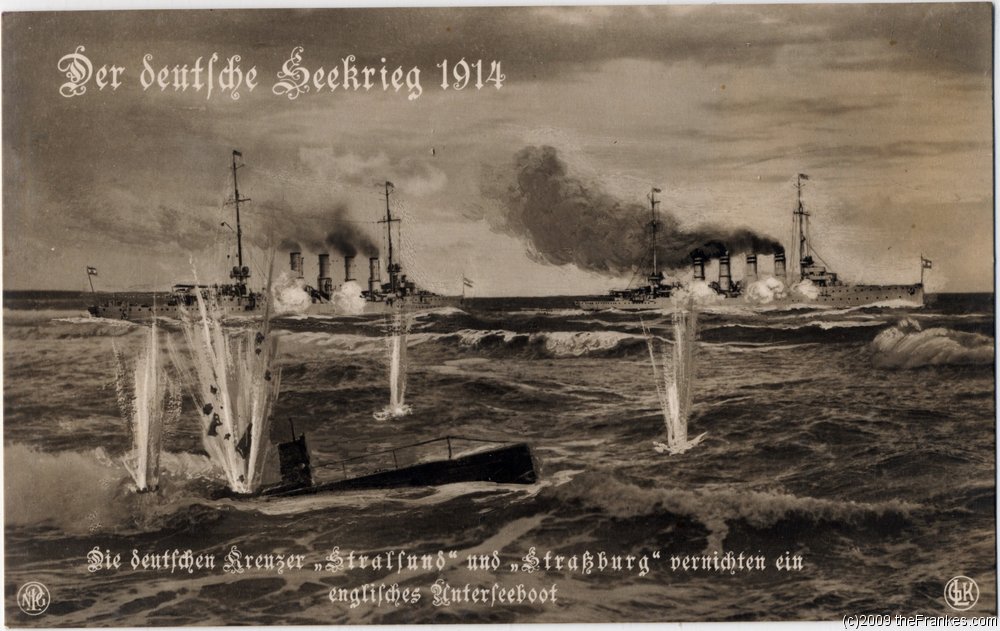
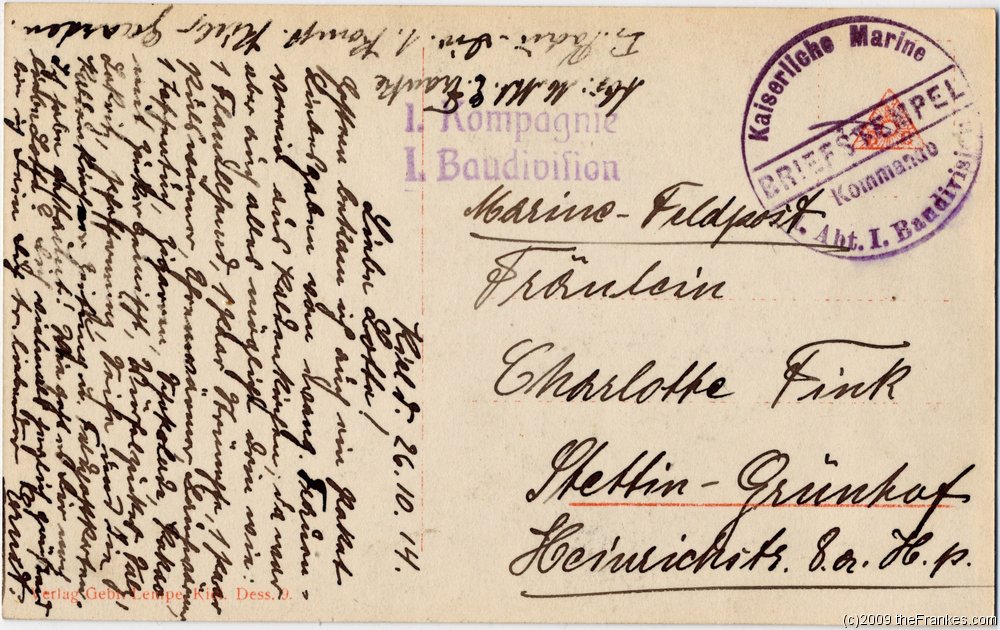
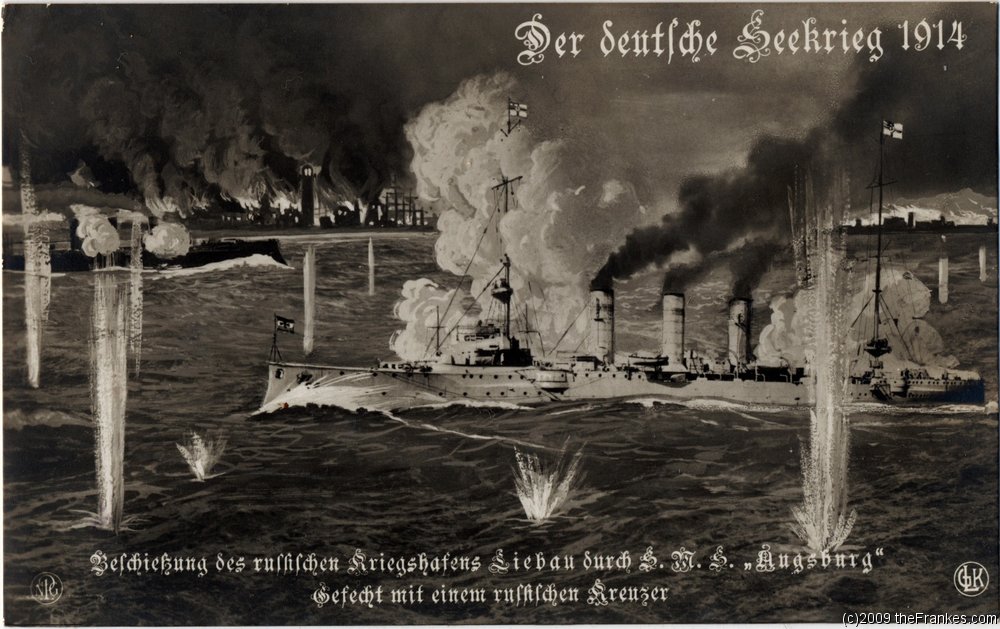
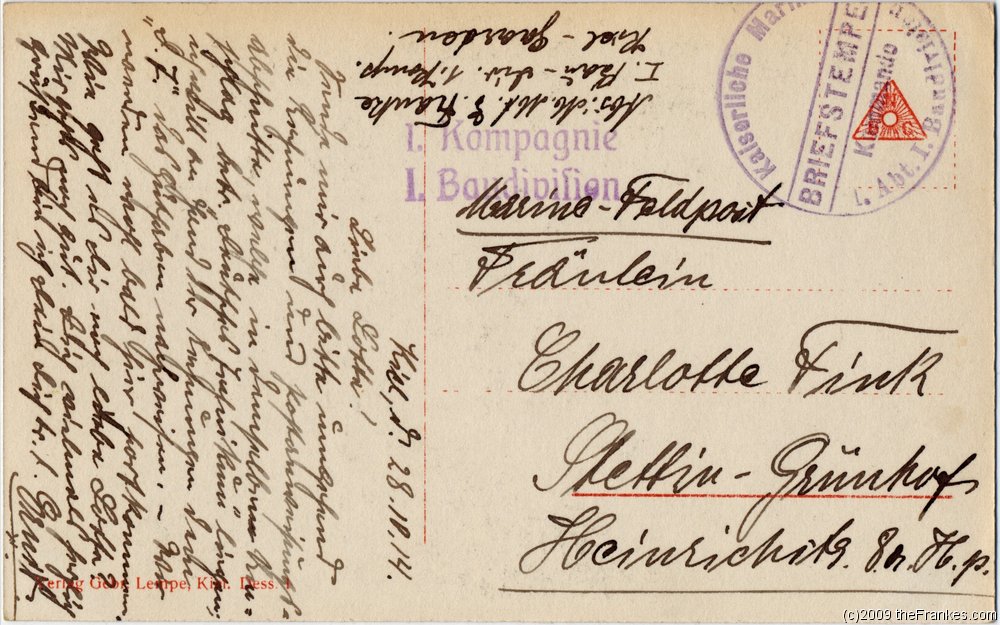
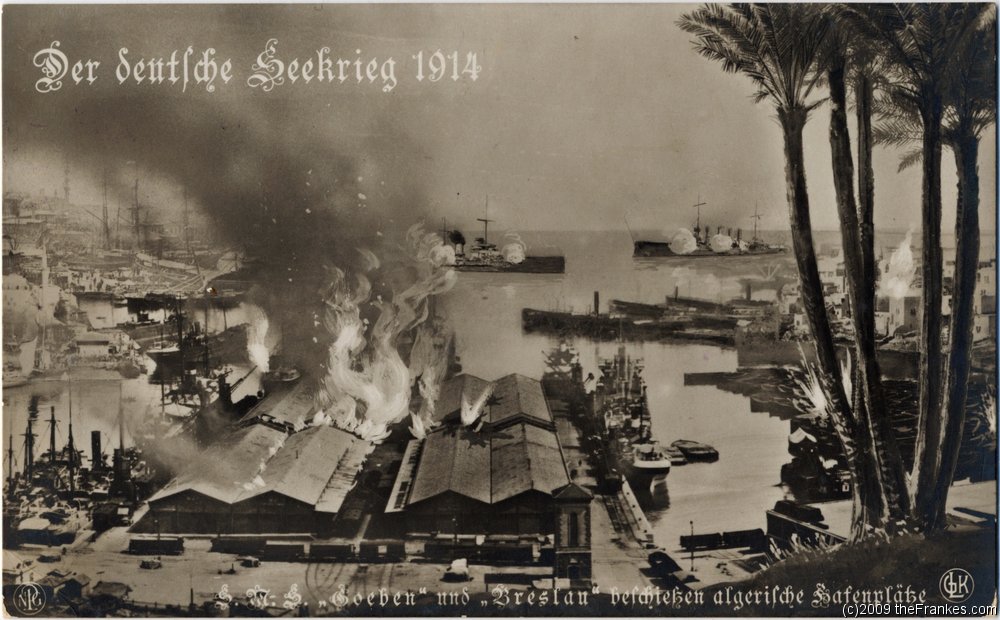
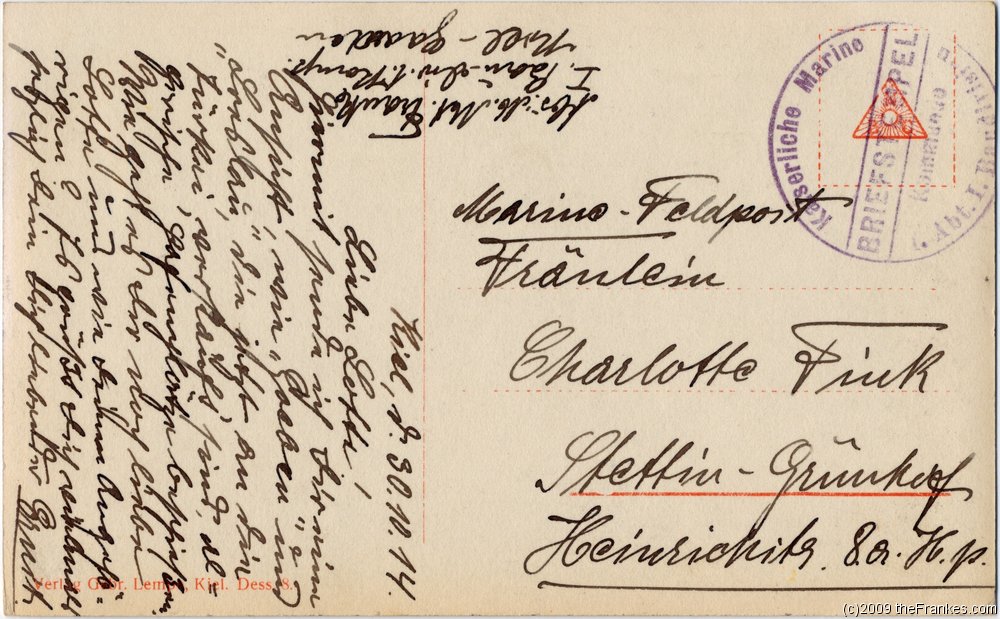
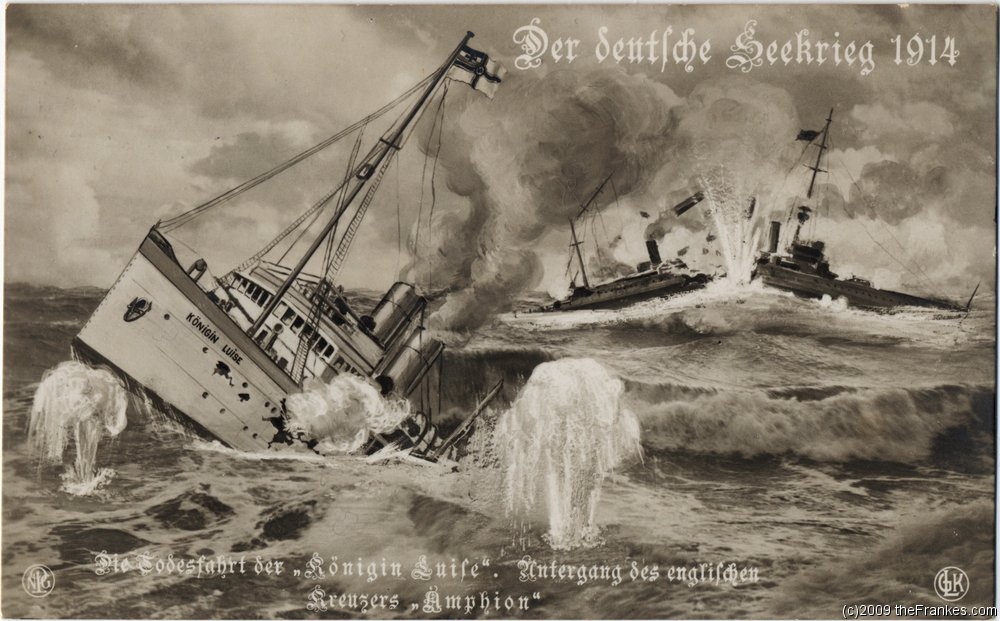
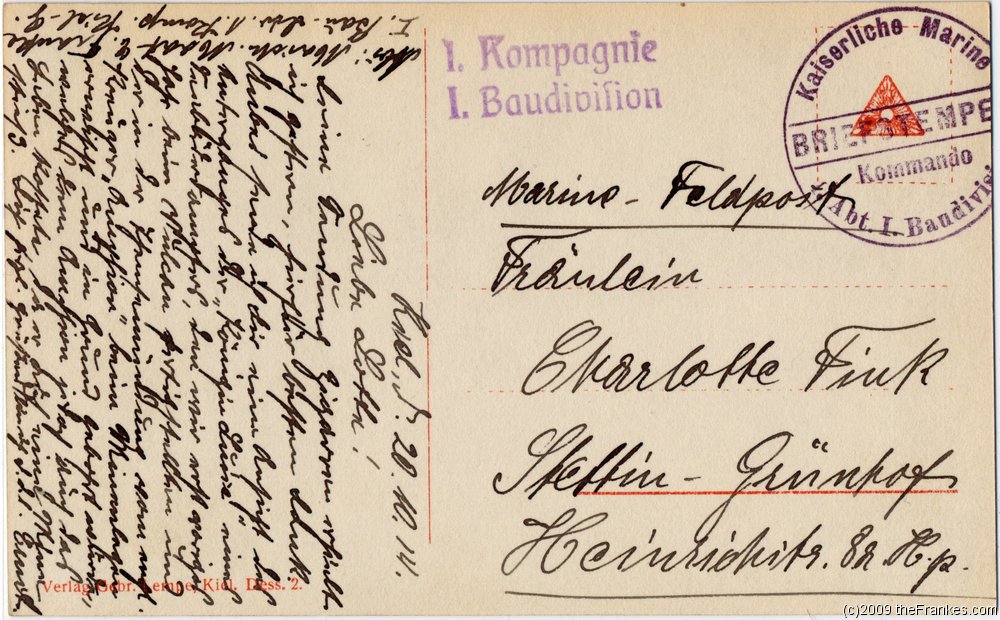
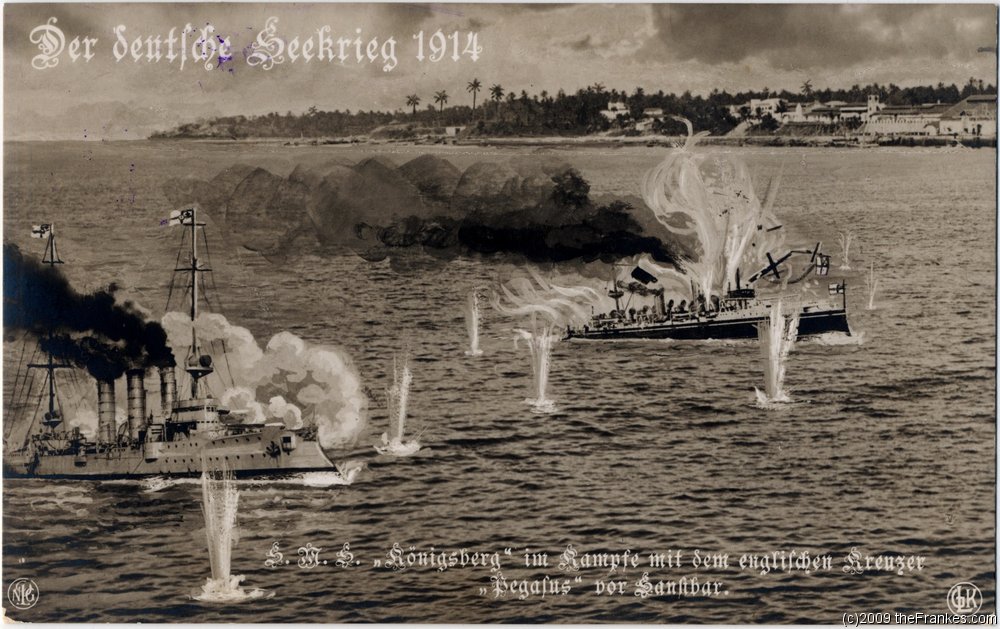
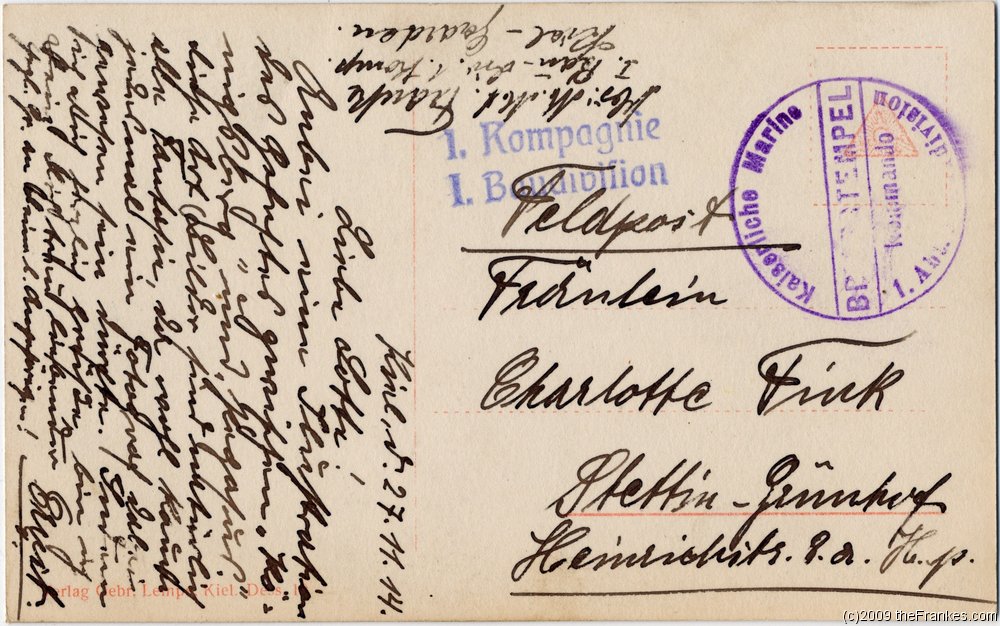
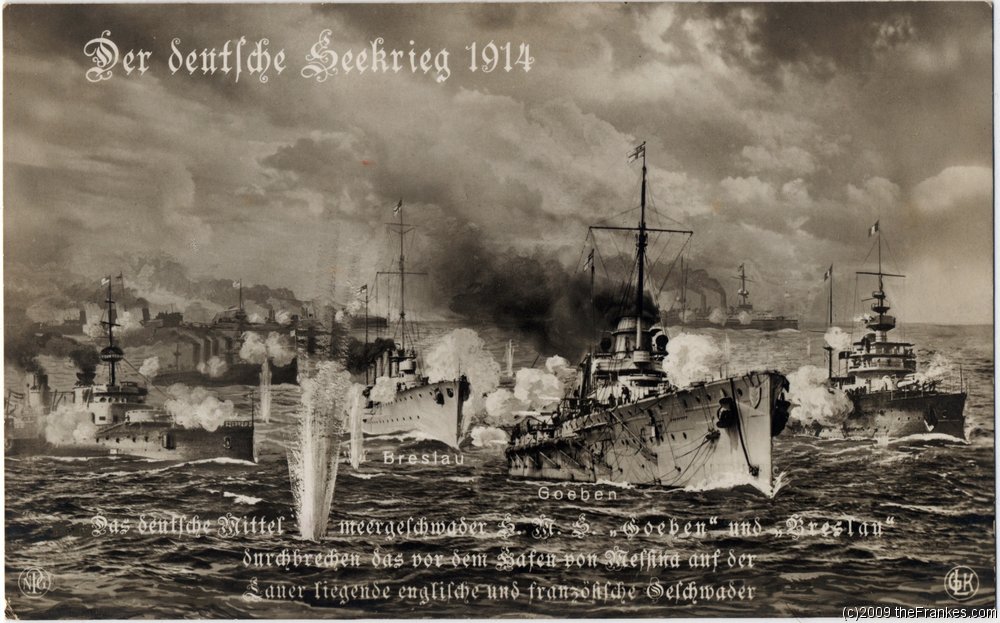
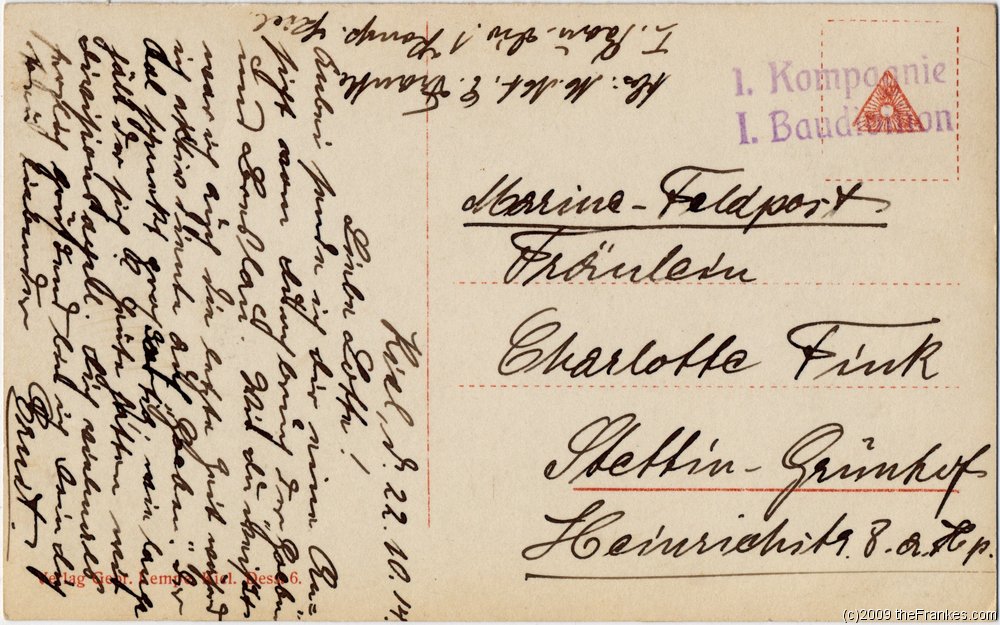
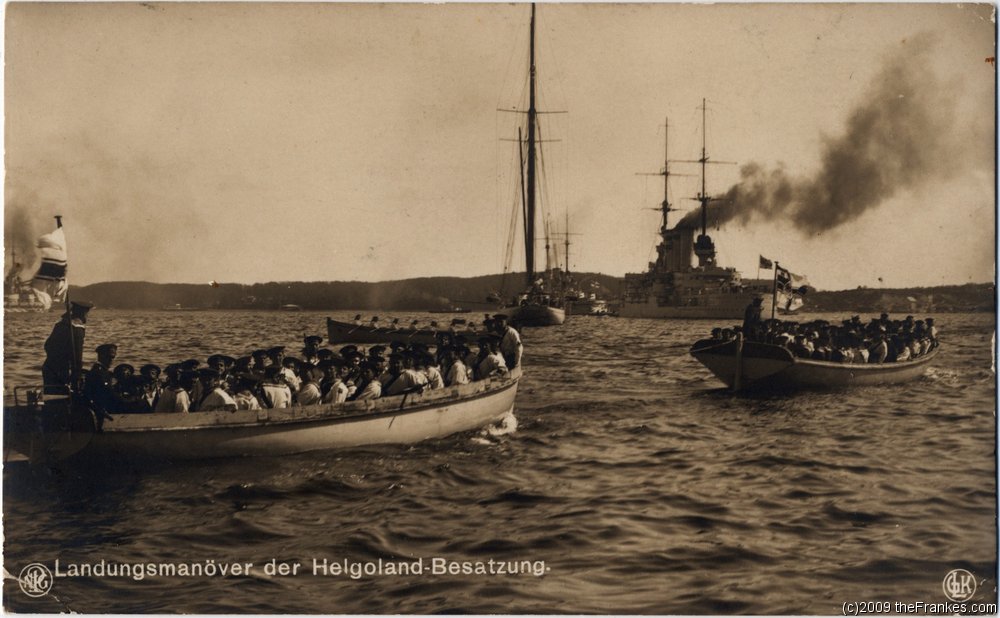
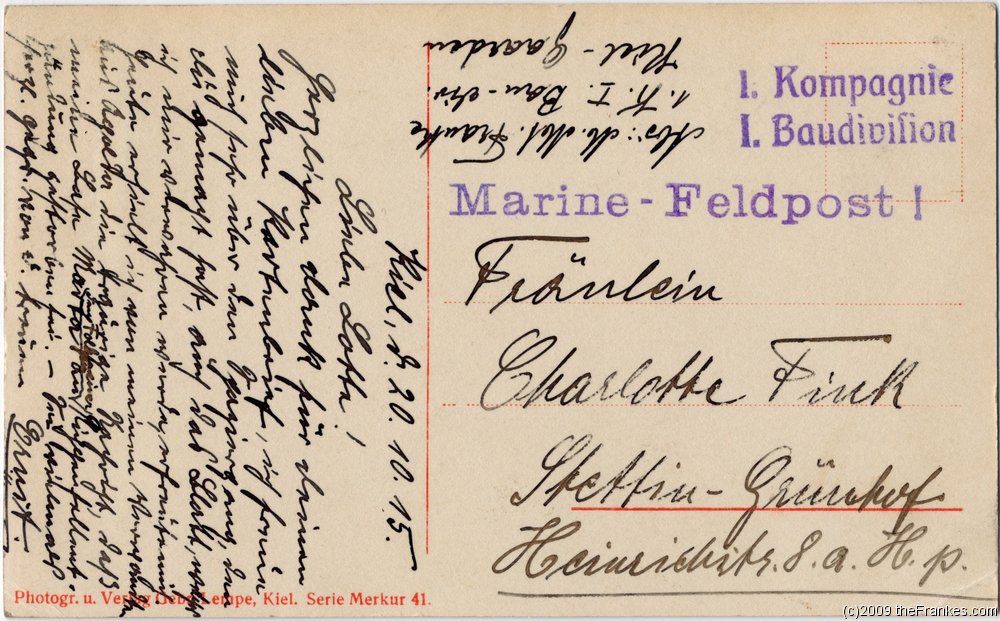
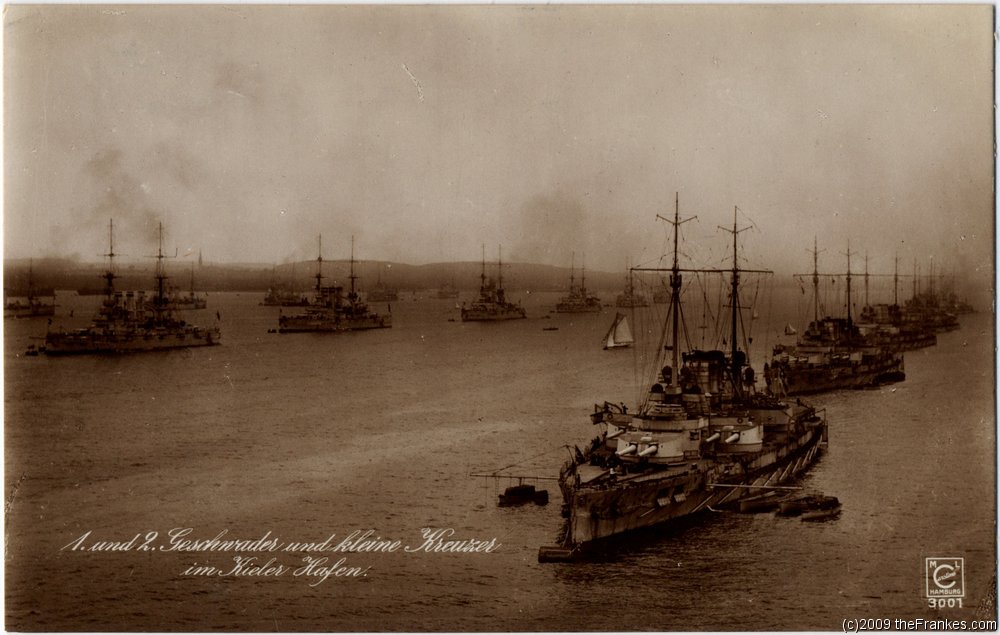
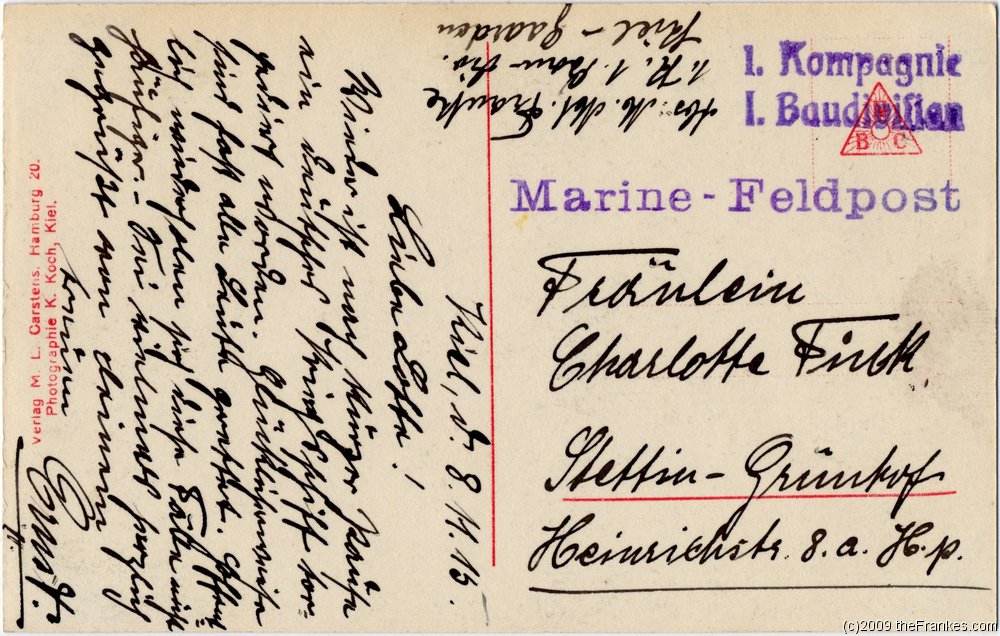

SET 37
1. Liebe Lotte! Kiel, d. 26.10.14
Gestern bekam ich auch ein Paket Liebesgaben vom evang(elischen) Frauenverein aus Kaldenkirchen; da war aber auch alles mögliche drin wie: 1 Flanellhemd, 1 Paar Strümpfe, 1 Paar Pulswärmer, Ohrenwärmer, Bauchwärmer, 1 Taschentuch, Zigarren, Schokolade, Kakao mit Zucker gemischt, Würfelzucker, Salz, Lakritz, Pfefferminz, Seife und die Kaldenkirchner Zeitung und Feldpostkarten. Ich habe gestaunt. Wie geht es Dir noch, liebe Lotte? Dich vielmals herzlich grüßend bin ich Dein Dich treu liebender Ernst.
Dear Lotte! Kiel, 26.10.14
Yesterday I received a love-package from the protestant women’s club of Kaldenkirchen, too; it contained many things like: 1 flanell shirt, 1 pair of socks, 1 pair of pulse warmers, ear-warmers, belly-warmer, 1 handkerchief, cigars, chocolate, cocoa mixed with sugar, lump sugar, salt, liquorice, peppermint and the newspaper of Kaldenkirchen and field-postcards. I was surprised. How are you, dear Lotte? With many affectionate greetings I am your truthful loving Ernst
2. Liebe Lotte! Kiel, d. 28.10.14
Sende mir auch bitte umgehend die Rechnungen und Postanweisungsabschnitte, welche in demselben Umschlag betr.(effs) „Deutsches Jubiläum“ liegen; ich will anhand der Rechnungen dem „D.F.“ das Guthaben nachweisen. – Wir werden wohl bald hier fortkommen. Wie geht es Dir noch liebe Lotte? Mir geht’s noch gut. Dich vielmals herzlich grüßend bin ich Dein Dich tr(eu) l(iebender) Ernst.
Dear Lotte! Kiel, 28.10.14
Please send me the receipts and postal money order receipts that are in the envelope titled “German Jubilee” as soon as possible; with the invoices I want to proof of the balance to “D.F.” – We will probably soon be sent to some other location. How are you, dear Lotte? I am still fine. With many affectionate greetings I am your truthful loving Ernst
3. Liebe Lotte! Kiel, d. 30.10.14
Hiermit sende ich Dir eine Ansicht wie „Goeben“ und „Breslau“, die jetzt an die Türkei verkauft sind, algerische Hafenplätze beschießen. Wie geht es Dir noch liebe Lotte und wie Deinen Angehörigen? Es grüßt Dich vielmals herzlich Dein Dich treu liebender Ernst
Dear Lotte! Kiel, 30.10.14
I am sending you a view of “Goeben” and “Breslau”, now sold to Turkey, shelling Algerian harbours. How are you, dear Lotte and how are your relatives? With many affectionate greetings I am your truthful loving Ernst
4. Liebe Lotte! Kiel, d. 20.10.14
Deine Sendung Zigarren erhielt ich gestern, hierfür besten Dank. Anbei sende ich Dir eine Ansicht des Untergangs der „Königin Louise“, eines Seebäderdampfers den wir erst voriges Jahr beim Vulcan fertig stellten und der in der Themsemündung vom engl.(ischen) Kreuzer „Amphion“ beim Minenlegen erwischt und in den Grund gebohrt wurde, welches dem Amphion jedoch auch das Leben kostete, da er auf eine Mine stieß. Dich herzl(ich) grüßend bin ich D(ein) D(ich) l(iebender) Ernst
Dear Lotte! Kiel, 20.10.14
I received the cigars you sent yesterday, many thanks. Enclosed I am sending a view of the sinking of “Königin Louise”, a seaside resort steamer built at Vulcan last year, she was caught in the Thames estuary while laying mines by the English cruiser “Amphion” and drilled into the ground; but It cost Amphion her life too as she collided with a mine. With many affectionate greetings I am your truthful loving Ernst
5. Liebe Lotte! Kiel, d. 27.11.14
Anbei eine Illustration des Gefechtes zwischen „Königsberg“ und „Pegasus“. Diese Art Bilder sind natürlich alle Fantasie, da wohl kaum jedes Mal ein Fotograf dabei gewesen sein dürfte. Indem ich Dich herzlich grüße bin ich Dein Dich treu liebender Ernst Herzl.(iche) Gr.(üße) an Deine l.(ieben) Abgehörigen!
Dear Lotte! Kiel, 27.11.14
Enclosed is an illustration of the engagement between “Königsberg” and “Pegasus”. Of course, this kind of pictures are pure fantasy, as there was hardly a photographer present. With many affectionate greetings I am your truthful loving Ernst Kind regards to your relatives.
6. Liebe Lotte! Kiel, d. 22.10.14
Anbei sende ich Dir eine Ansicht vom Durchbruch der „Goeben“ und Breslau. Wie Du weißt war ich auch die letzte Zeit während ich aktiv diente auf „Goeben“. Der Aal schmeckt großartig; wie lange hält der sich? Dich vielmals herzlich grüßend bin ich Dein Dich treu liebender Ernst.
Dear Lotte! Kiel, 22.10.14
Enclosed is a view of the penetration of “Goeben” and Brelau. As you know, I was on “Goeben” for the last part of my active service. The eel tastes great, for how long will it be fresh? With many affectionate greetings I am your truthful loving Ernst
7. Liebe Lotte! Kiel, d. 20.10.15
Herzlichen Dank für Deinen lieben Kartenbrief; ich freue mich sehr über den Spaziergang, den Du gemacht hast, auch das Blatt, welches ich mir verwahren werde erfreute mich. Heute erhielt ich von meinen Verwandten aus Apolda die traurige Nachricht, dass meine Base Marta an den Folgen einer Rippenfellentzündung gestorben sei. Sei vielmals herzl.(ich) gegr.(üßt) von D(einem) treuen Ernst.
Dear Lotte! Kiel, 20.10.15
Many thanks for your dear card letter, I am very delighted about the walk you made, also, the leaf – which I will keep – delighted me. Today I received the sad news from my relatives at Apolda (a town in Saxony) that my cousin Marta has died from the effects of a pleurisy. With many affectionate greetings I am your truthful loving Ernst
8. Liebe Lotte! Kiel, 8.11.15
Wieder ist nach kurzer Pause ein deutsches Kriegsschiff torpediert worden. Glücklicherweise sind fast alle Leute gerettet. Hoffentlich wiederholen sich diese Fälle nicht häufiger. Sei vielmals herzlich gegrüßt von Deinem treuen Ernst.
Dear Lotte! Kiel, 08.11.15
After a short break a German warship has been torpedoed again. Luckily nearly all crew members were rescued. I hope these incidents will not be repeated too often. With many affectionate greetings I am your truthful Ernst
SET 37
#1 There is no record of “Straßburg” and “Stralsund” sinking a British submarine in a surface action. – The British submarine “D5” was, however lost on November 3, 1914 on mines laid by “Stralsund” previously during the naval bombardement of Yarmouth by German battle cruisers.
#2 The small cruiser “Augsburg” shelled the Russian naval port of Libau (or Liebau) on August, 2, 1914 (less than 24 hours after the German declaration of war upon Russia), some of the first shots of the First World War at sea. The reported Russian cruiser is unknown.
“Ru????che” should read “russische”
#3 “Goeben” and “Breslau” shelled the Algerian ports of Bone and Philippeville on August 4, 1914 (less than 24 hours after the German declaration of war upon France) to impede the embarkation of French colonial troops which were meant to go to the front in France. Both ships did not, of course, close the ports that far, there´s an artist´s imagination at play.
“Breslan” should read “Breslau”
#4 The “Königin Luise”, a former ferry between Germany and great Britain, had been converted to an auxiliary minelayer at very short notice and had laid mines off the Thames estuary on August, 5, 1914 (less than 24 hours after the British declaration of war upon Germany). The minelaying had been observed by a fishing boat. British warships, among them the modern scout cruiser “Amphion”, chased and sank the “Königin Luise”in the late afternoon of August, 5. Early on the next morning, the “Amphion” was lost on the laid mines, too, a number of rescued German seamen going down with the british ship. The simultaneous sinking of both ships is shown, again, due to the artist´s imagination.
#5 The small cruiser “Königsberg” sank the obsolete British cruiser “Pegasus” in the harbour of Zanzibar on September 20, 1914, within one hour. The fighting distance was, however, more than 10,000 yards and not as close as shown (again, artist´s impression) (further info see Set 25, #6)
# 6 The naval action shown in this picture did not take place and is, once more, an artist´s imagination. After shelling the Algerian ports (see #3) “Goeben” and “Breslau” put into port at Messina (Italy being neutral) to resupply coal. On the way to Messina the ships met two British battlecruisers, but there was no action as war had not been declared, yet. The British ships were unable to match the German ships´speed and could not follow their track. On August, 5, after the declaration of war between Great Britain and Germany, British ships were stationed north of Messina (to prevent further attacks on French troop convoys) and at the mouth of the Adria (to prevent the german ships to go to Austro-Hungarian ports). The southern entrance of Messina strait was guarded, however, by the light cruiser “Gloucester”, only. When the German ships left Messina in the afternoon of August, 6, “Gloucester had to remain outside the range of “Goeben”s far superior guns. The remainder of the story, “Goeben” and “Breslau” proceeding to Constantinople, has been told, already.
Greetings, Urs
Urs:
Hi,Alex,
here is the remainder of comments to sets 37-40
As Ernst indicates in his text in card #5, all six pictures of “The war at Sea 1914” are dominated by the artist´s imagination. The fighting distances are much less than in reality (#3 and 5), in one case history has been bent further to the extent that the action did not take place, at all
#8 – The ship Ernst refers to as “torpedoed” was the small and rather obsolete cruiser “Undine” (see Set 38, #8) which was sunk by the British submarine “E 19”, Commander Cromie, on November 7, 1915, north-east of the island of Rügen (Arkona). There were not many victims, 6 dead and another 8 men missing, the bulk of the crew being rescued by a torpedo boat and a ferry. Ernst´s “After a short break … again” refers to the fact that two weeks earlier, on October, 23, another British submarine, “E 8”, Commander Goodeheart, had sunk the old armoured cruiser “Prinz Adalbert”with heavy loss of life (672 dead, see Set 5, #4). Ernst´s wish that “these incidents (i.e., British submarine successes against German warships) will not be repeated too often” came true.
Urs:
SET 37
#8 – The dreadnoughts of the Ostfriesland-class, belonging to the 1st squadron (1. Geschwader) are on the right side, the older pre-dreadnought battleships of the “Deutschland”-class, belonging to the 2nd squadron (2. Geschwader) are on the left side.
Also Set 43 #1 is this photo (set 37 #8) turned into a picture